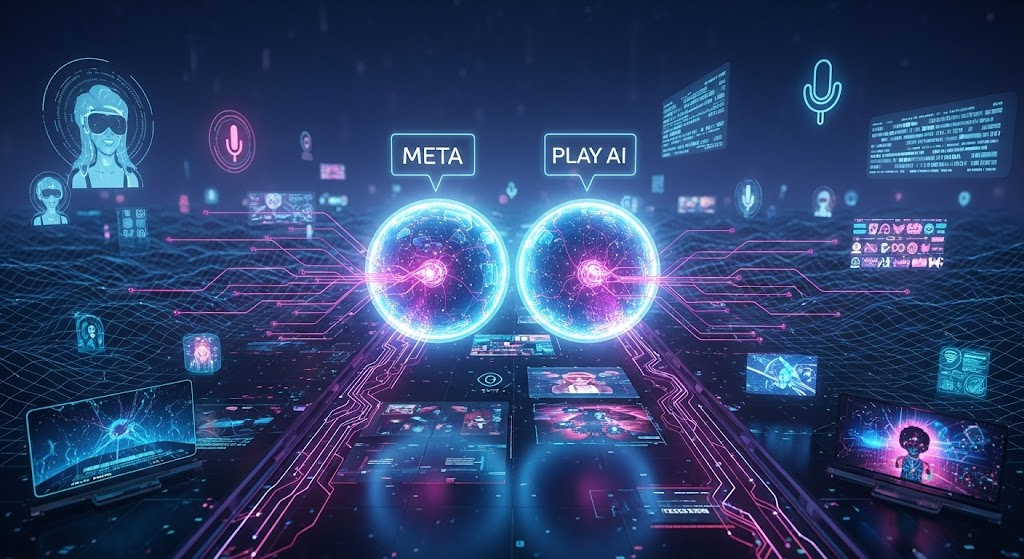In the ever-evolving landscape of gaming and virtual experiences, voice is rapidly becoming the next frontier. With Meta’s recent acquisition of Play AI—a voice technology startup—one thing is certain: how we interact within digital spaces is about to shift in profound ways. No longer will gamers rely solely on buttons or touchscreens. Instead, voice interaction will lead the charge into more immersive, more human, and more intelligent virtual worlds.
This change is bigger than just shouting commands at your character. It’s about creating fully conversational AI companions, responsive NPCs (non-playable characters), and real-time voice-controlled experiences that blur the lines between real and digital. In this blog, we explore how Meta’s Play AI is poised to redefine voice interaction across virtual environments and what that means for developers, gamers, and 3D game character design services.
Meta + Play AI: A Strategic Match Made in the Metaverse

Meta’s acquisition of Play AI wasn’t just a business move it was a signal. Play AI brings cutting-edge conversational voice tech that enables real-time, natural dialogue. Meta, on the other hand, is building the infrastructure for the next-generation metaverse. Combine the two, and the result is a powerful ecosystem where voice becomes the core interface for everything from social VR to gameplay.
This union promises seamless integration of AI-powered voice systems across Meta’s platforms, including Horizon Worlds, Quest, and beyond. With Play AI’s advanced language understanding and emotional awareness, voice-controlled interactions are on track to become as intuitive as talking to another human. This will enhance player immersion and elevate the realism of digital characters, changing how users experience virtual spaces.
Redefining Immersion
Gamepads and VR motion controllers may never go away, but voice commands are quickly becoming just as vital. Imagine navigating a fantasy RPG simply by speaking: issuing squad orders, casting spells, or asking an NPC for directions—all without a single button press.
With Play AI, voice will no longer be a novelty. It will be foundational. Players will engage in full conversations with characters, not just bark one-word commands. This allows for greater emotional expression and contextual nuance. As a result, game developers and 3D game character design services will need to craft characters capable of interpreting and responding to human speech in real time.
NPCs That Actually Listen
Traditionally, NPCs have operated within narrow, scripted parameters. Ask them something unexpected, and they deliver a canned “I don’t know what you mean.” But with Play AI’s integration, NPCs will evolve into conversational partners with distinct personalities, backstories, and adaptive behavior.
Meta’s investment in generative voice AI will make it possible for characters to respond intelligently even humorously to whatever the player says. This opens new doors for storytelling and player agency. Game studios and 3D game character design services will now need to create not only realistic visuals but also believable, voice-enabled personalities that feel genuinely alive.
Voice-Driven Social Interaction in the Metaverse
Social interaction is at the core of Meta’s vision. With voice AI, digital communication becomes more human and expressive. Whether you’re in a virtual workspace or hanging out in Horizon Worlds, talking will feel more natural thanks to Play AI’s real-time processing and adaptive feedback.
Voice will allow users to form deeper relationships in virtual spaces. It adds a layer of authenticity, from tone and inflection to sentiment detection. Meta’s Play AI could power everything from digital dating in VR to collaborative creation in game worlds—enabling verbal brainstorming, negotiation, and shared storytelling.
Read Also >>> Innovative Strategies for Engaging Users in Online Platforms
Empowering Accessibility
Voice interaction isn’t just a novelty; it’s an accessibility tool. Gamers with limited mobility often face challenges when it comes to traditional controls. With Play AI, they can navigate, fight, and interact simply by speaking.
This democratizes access to games and virtual worlds, allowing more people to engage with immersive environments. It also forces 3D game character design services to consider new paradigms in interaction design ones that prioritize voice-first experiences from the ground up.
6. Real-Time Emotion Recognition and Adaptive Gameplay
Play AI isn’t just about interpreting what users say it also understands how they say it. With advanced sentiment analysis, the AI can detect joy, frustration, sarcasm, or excitement. This gives developers the power to adjust gameplay dynamically, based on a player’s emotional state.
For example, if a player sounds anxious, the game could dial down combat intensity or offer support through in-game companions. This creates a more personalized and emotionally intelligent game experience, putting even more pressure on studios and 3D game character design services to deliver emotionally aware characters.
Revolutionizing Game Design with Natural Dialogue Trees
Game design will need to shift significantly to accommodate free-form voice input. Traditional dialogue trees where players select from a few prewritten options will give way to open-ended conversations. Play AI will understand context, nuance, and intent, enabling a new kind of storytelling.
This transition also demands a new kind of character writing. Writers and designers must think less like scriptwriters and more like psychologists, linguists, and improvisers. 3D game character design services must collaborate more closely with AI and voice experts to bring these new forms of expression to life.
Development Challenges and Opportunities
Of course, integrating voice AI into virtual worlds isn’t without its hurdles. Developers must deal with latency, data privacy, voice recognition errors, and the sheer unpredictability of natural human speech. There’s also the challenge of making characters sound and feel distinct—not just AI clones with slightly different voices.
However, the upside is enormous. Developers who embrace this shift early will be at the forefront of the next big wave in interactive media. Game design studios and 3D game character design services have a rare opportunity to shape the future of gaming by crafting voices, personalities, and visuals that are unforgettable.
The Role of 3D Game Character Design in a Voice-First World
As voice takes center stage, the role of 3D game character design services becomes even more crucial. Characters will no longer just look real they’ll need to act and sound real too. This means designing facial expressions that sync with speech, body language that reflects tone, and aesthetics that match vocal personalities.
Collaboration between animators, voice engineers, and AI specialists will be essential. Every character becomes a performer, and every game becomes a stage for natural interaction. Voice and visual design will go hand in hand, creating digital actors that live and breathe in real time.
Conclusion
Meta’s Play AI isn’t just an upgrade it’s a paradigm shift. Voice interaction will become the most intuitive, natural, and immersive form of communication in virtual spaces. From smarter NPCs and personalized gameplay to accessible design and deeper emotional engagement, the possibilities are enormous.
For gamers, it means richer experiences. For developers, it means new tools, new challenges, and new creative frontiers. And for 3D game character design services, it signals a golden age where character design is as much about voice as it is about vision. As we move into a voice-first era of gaming and the metaverse, the future sounds very exciting indeed.
Read More: Call of Duty Black Ops 7







